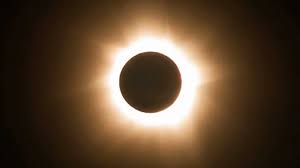
Recently, scientists have found rust on the Moon which is causing the Moon to turn red. The Moon turns red during an eclipse because of how the Sun’s light interacts with Earth’s atmosphere. As it hits the atmosphere, shorter wavelengths of light such as the color blue are scattered outwards. Longer wavelengths like red, however, are bent or refracted into Earth’s umbra.
The good thing about all types of lunar eclipse is that, unlike a solar eclipse, they are safe to view with the naked eye. This is because lunar eclipses only reflect sunlight – they don’t get any brighter than a full moon, which everyone has probably safely observed many times before.
A lunar eclipse only occurs during a full Moon, when the Sun, Earth and Moon are all aligned. There are only on average about three lunar eclipses every year.
This is because the Moon’s orbit around Earth is not in a flat plane. It’s angled at about five degrees, which means that the Moon often goes above or below Earth’s shadow as it orbits around. As a result, lunar eclipses tend to come in batches when the Moon is at a similar inclination. There were three total lunar eclipses in 2018.




